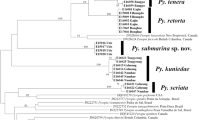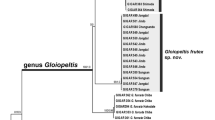Abstract
We applied DNA barcoding analysis to the red alga Grateloupia because it is one of the most complicated taxa in the family Halymeniaceae. We used two DNA barcoding markers, the 5′ end of the cytochrome c oxidase I gene and the universal plastid amplicon of the 23S rRNA gene, to define levels of genetic diversity and species relationships within rbcL phylogeny. We detected nine species of Grateloupia, four species of Pachymeniopsis, and one Kintokiocolax in Korea: G. angusta, G. asiatica, G. catenata, G. divaricata, G. imbricata, G. jejuensis, G. kurogii, G. subpectinata, G. turuturu, P. elliptica, P. gargiuli, P. lanceolata, a new species, and K. aggregato-cerantha. The COI-5P barcode successfully differentiated species, with interspecific divergence values ranging between 3.7 and 14 %. Barcoding data provided a rapid and accurate methodology for species-level identification and for taxonomic explorations when used in combination with morphological data. We describe Pachymeniopsis volvita sp. nov. based on DNA barcoding analysis. Fourteen species detected in four different subclades with strong bootstrap support within rbcL phylogenetic tree.




Similar content being viewed by others
References
Bellorin AM, Buriyo A, Sohrabipour J, Oliveira MC, Oliveira EC (2008) Gracilariopsis mclachlanii sp. nov. and Gracilariopsis persica sp. nov. of the Gracilariaceae (Gracilariales, Rhodophyceae) from the Indian Ocean. J Phycol 44:1022–1032
Clarkston BE, Saunders GW (2010) A comparison of two DNA barcode markers for species discrimination in the red algal family Kallymeniaceae (Gigartinales, Florideophyceae), with a description of Euthora timburtonii sp. nov. Botany 88:119–131
D’Archino RD, Nelson WA, Zuccarello GC (2007) Invasive marine red alga introduced to New Zealand waters: first record of Grateloupia turuturu (Halymeniaceae, Rhodophyta). N Z J Mar Freshw Res 41:35–42
Dawczynski C, Schubert R, Jahreis C (2007) Amino acids, fatty acids, and dietary fibre in edible seaweed products. Food Chem 103:891–899
De Clerck O, Gavio B, Fredericq S, Bárbara I, Coppejans E (2005) Systematics of Grateloupia filicina (Halymeniaceae, Rhodophyta), based on rbcL sequence analyses and morphological evidence, including the reinstatement of G. minima and the description of G. capensis sp. nov. J Phycol 41:391–410
Denis C, Jeune HL, Gaudin P, Fleurence J (2009a) An evaluation of methods for quantifying the enzymatic degradation of red seaweed Grateloupia turuturu. J Appl Phycol 21:153–159
Denis C, Morancais M, Gaudin P, Fleurence J (2009b) Effect of enzymatic digestion on thallus degradation and extraction of hydrosoluble compounds from Grateloupia turuturu. Bot Mar 52:262–267
Denis C, Morancais M, Li M, Deniaud E, Gaudin P, Wielgosz-Collin G, Barnathan G, Jaouen P, Fleurence J (2010) Study of the chemical composition of edible red macroalgae Grateloupia turuturu from Brittany (France). Food Chem 119:913–917
Faye ET, Wang HW, Kawaguchi S, Shimada S, Masuda M (2004) Reinstatement of Grateloupia subpectinata (Rhodophyta, Halymeniaceae) based on morphology and rbcL sequences. Phycol Res 52:59–68
Garcia-Jiménez P, Geraldino PJL, Boo SM, Robaina RR (2008) Red alga Grateloupia imbricata (Halymeniaceae), a species introduced into the Canary Islands. Phycol Res 56:166–171
Gargiulo GM, Morabito M, Manghisi A (2013) A re-assessment of reproductive anatomy and postfertilization development in the systematic of Grateloupia (Halymeniales, Rhodophyta). Cryptogam Algol 34:3–35
Gavio B, Fredericq S (2002) Grateloupia turuturu (Halymeniaceae, Rhodophyta) is the correct name of the non-native species in the Atlantic known as Grateloupia doryphora. Eur J Phycol 37:349–360
Geraldino PJL, Yang EC, Kim MS, Boo SM (2009) Systematics of Hypnea asiatica sp. nov. (Hypneaceae, Rhodophyta) based on morphology and nrDNA SSU, plastid rbcL, and mitochondrial cox1. Taxon 58:606–616
Hall TA (1999) BioEdit: a user-friendly biological sequence alignment editor and analysis program for Windows 95/98/NT. Nucleic Acids Symp Ser 41:95–98
Hebert PDN, Cywinska A, Ball SL, deWaard JR (2003) Biological identifications through DNA barcodes. Proc R Soc Lond B 270:313–321
Hebert PDN, Stoeckle MY, Zemlak TS, Francis CM (2004) Identification of birds through DNA barcodes. PLoS Biol 2:1657–1663
Inderjit CD, Ranelletti M, Kaushik S (2006) Invasive marine algae: an ecological perspective. Bot Rev 72:153–178
Kawaguchi S (1989) The genus Prionitis (Halymeniaceae, Rhodophyta) in Japan. J Fac Sci Hokkaido Univ Series V (Botany) 16:193–257
Kawaguchi S (1990) Grateloupia kurogii, a new species of the Halymeniaceae (Rhodophyta) from Japan. Jap J Phycol 38:135–146
Kawaguchi S (1997) Taxonomic notes on the Halymeniaceae (Gigartinales, Rhodophyta) from Japan, III. Synonymization of Pachymeniopsis Yamada in Kawabata with Grateloupia C. Agardh. Phycol Res 45:9–21
Kawaguchi S, Wang HW, Horiguchi T, Sartoni G, Masuda M (2001) A comparative study of the red alga Grateloupia filicina (Halymeniaceae) from the northwestern Pacific and Mediterranean with the description of Grateloupia asiatica, sp. nov. J Phycol 37:433–442
Kim MS, Yang EC, Kim SY, Hwang IK, Boo SM (2008) Reinstatement of Gracilariopsis chorda (Gracilariaceae, Rhodophyta) based on plastid rbcL and mitochondrial cox1 sequences. Algae 23:209–217
Kim MS, Kim SY, Nelson W (2010) Symphyocladia lithophila sp. nov. (Rhodomelaceae, Ceramiales), a new Korean red algal species based on morphology and rbcL sequences. Bot Mar 53:233–241
Kim SY, Han EG, Kim MS, Park JK, Boo SM (2013) Grateloupia jejuensis (Halymeniales, Rhodophyta): a new species previously confused with G. elata and G. cornea in Korea. Algae 28:233–240
Kim SY, Manghisi A, Morabito M, Yang EC, Yoon HS, Miller KA, Boo SM (2014) Genetic diversity and haplotype distribution of Pachymeniopsis gargiuli sp. nov. and P. lanceolata (Halymeniales, Rhodophyta) in Korea, with notes on their non-native distributions. J Phycol. Doi:10.1111/jpy.12218-13-242
Kucera H, Saunders GW (2012) A survey of Bangiales (Rhodophyta) based on multiple molecular markers reveals cryptic diversity. J Phycol 48:869–882
Le Gall L, Saunders GW (2010) DNA barcoding is a powerful tool to uncover algal diversity: a case study of the Phyllophoraceae (Gigartinales, Rhodophyta) in the Canadian flora. J Phycol 46:374–389
Lee HB, Lee IK (1993) A taxonomic study on the genus Pachymeniopsis Halymeniaceae, Rhodophyta in Korea. Korean J Phycol 8:55–65
Lin SM, Liang HY, Hommersand MH (2008) Two types of auxiliary cell ampullae in Grateloupia (Halymeniaceae) including G. taiwanensis sp. nov. and G. orientalis sp. nov. from Taiwan based on rbcL gene sequence analysis and cystocarp development. J Phycol 44:196–214
Mathieson AC, Dawes CJ, Pederson J, Gladych RA, Carlton JT (2008) The Asian red seaweed Grateloupia turuturu (Rhodophyta) invades the Gulf of Maine. Biol Invasions 10:985–988
Miller KA, Hughey JR, Gabrielson PW (2009) First report of the Japanese species Grateloupia lanceolata (Halymeniaceae, Rhodophyta) from California, USA. Phycol Res 57:238–241
Okamura K (1934) Icones of Japanese algae, vol 7 pp. 19–48 (English), 17–44 (Japanese). Plates CCCXI-CCCXXV, Tokyo
Saunders GW (2005) Applying DNA barcoding to red macroalgae: a preliminary appraisal holds promise for future applications. Philos Trans R Soc Lond B 360:1879–1888
Saunders GW (2008) A DNA barcode examination of the red algal family Dumontiaceae in Canadian waters reveals substantial cryptic species diversity. 1. The foliose Dilsea–Neodilsea complex and Weeksia. Botany 86:773–789
Saunders GW, Withall RD (2006) Collections of the invasive species Grateloupia turuturu (Halymeniales, Rhodophyta) from Tasmania, Australia. Phycologia 45:711–714
Sheng YW, Zhang W, Zhao D, Wang HW (2012) A morphological and molecular assessment of the genus Sinotubimorpha (Halymeniaceae, Rhodophyta). J Syst Evol 50:146–152
Sherwood AR, Presting GG (2007) Universal primers amplify a 23S rDNA plastid marker in eukaryotic algae and cyanobacteria. J Phycol 43:605–608
Sherwood AR, Kurihara A, Conklin KY, Sauvage T, Presting GG (2010) The Hawaiian Rhodophyta biodiversity survey (2006–2010): a summary of principal findings. BMC Plant Biol 10:1–29
Simon C, ArGall E, Deslandes E (2001) Expansion of the red alga Grateloupia doryphora along the coasts of Brittany (France). Hydrobiologia 443:23–29
Stamatakis A (2006) RAxML-VI-HPC: maximum likelihood- based phylogenetic analyses with thousands of taxa and mixed models. Bioinformatics 22:2688–2690
Tamura K, Dudley J, Nei M, Kumar S (2007) MEGA 4: molecular evolutionary genetic analysis (MEGA) software version 4.0. Mol Biol Evol 24:1596–1599
Tanaka T, Nozawa Y (1960) One red algal parasite from Japan. Mem Fac Fish Kagoshima Univ 9:107–113
Verlaque M, Brannock PM, Komatsu T, Villalard-Bohnsack M, Marston M (2005) The genus Grateloupia C. Agardh (Halymeniaceae, Rhodophyta) in the Thau Lagoon (France, Mediterranean): a case study of marine plurispecific introductions. Phycologia 44:477–496
Wang HW, Kawaguchi S, Horiguchi T, Masuda M (2000) Reinstatement of Grateloupia catenata (Rhodophyta, Halymeniaceae) on the basis of morphology and rbcL sequences. Phycologia 39:228–237
Wang HW, Kawaguchi S, Horiguchi T, Masuda M (2001) A morphological and molecular assessment of the genus Prionitis J. Agardh (Halymeniaceae, Rhodophyta). Phycol Res 49:251–262
Wang SC, Bligh SWA, Shi SS, Wang ZT, Hu ZB, Crowder J, Branford-White C, Vella C (2007) Structural features and anti-HIV-1 activity of novel polysaccharides from red algae Grateloupia longifolia and Grateloupia filicina. Int J Biol Macromol 41:369–375
Wilkes RJ, McIvor LM, Guiry MD (2005) Using rbcL sequence data to reassess the taxonomic position of some Grateloupia and Dermocorynus species (Halymeniaceae, Rhodophyta) from the north-eastern Atlantic. Eur J Phycol 40:53–60
Yang MY, Han EG, Kim MS (2013) Molecular identification of Grateloupia elliptica and G. lanceolata (Rhodophyta) inferred from plastid rbcL and mitochondrial COI genes sequence data. Genes Genom 35:239–246
Zhao D, Wang HW, Sheng YW, Lu JZ, Luan RX (2012) Morphological observation and rbcL gene sequences studies of two new species, Grateloupia dalianensis H.W. Wang et D. Zhao, sp. nov. and G. yinggehaiensis H.W. Wang et R.X. Luan, sp. nov. (Halymeniaceae, Rhodophyta) from China. Acta Oceanol Sin 31:109–120
Acknowledgments
We thank Mr. J.C. Kang for collecting samples from the subtidal and other members of the molecular phylogeny of marine algae laboratory at Jeju National University. This study was supported by a grant from the National Institute of Biological Resources (NIBR), funded by the Ministry of Environment (MOE) of the Republic of Korea (NIBR No. 2013-02-001 for collecting samples and NIBR No. 2012-02-042 for molecular phylogeny of Korean major taxa).
Author information
Authors and Affiliations
Corresponding author
Rights and permissions
About this article
Cite this article
Yang, M.Y., Kim, M.S. Taxonomy of Grateloupia (Halymeniales, Rhodophyta) by DNA barcode marker analysis and a description of Pachymeniopsis volvita sp. nov.. J Appl Phycol 27, 1373–1384 (2015). https://doi.org/10.1007/s10811-014-0432-1
Received:
Revised:
Accepted:
Published:
Issue Date:
DOI: https://doi.org/10.1007/s10811-014-0432-1




